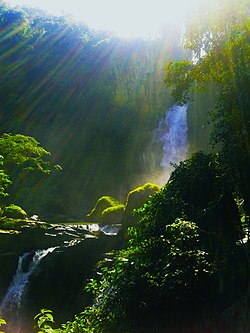| Ciletuh-Palabuhanratu Geopark | |
|---|---|
| Taman Bumi Ciletuh-Palabuhanratu | |
 Curug Cimarinjung waterfall | |
| Location | Pelabuhan Ratu, West Java, Indonesia |
| Nearest city | Sukabumi |
| Coordinates | 6°58′29″S 106°31′40″E / 6.974610°S 106.527763°E[1] |
| Area | 128,000 ha (320,000 acres) |
| [1] | |
Ciletuh-Palabuhanratu Geopark (Indonesian: Taman Bumi Ciletuh-Palabuhanratu) is a national Geopark at Pelabuhan Ratu of Sukabumi Regency in West Java, Indonesia. It was recognized by UNESCO in 2015 as a national geopark. It was proposed to become a member of the Global Geopark Network (GGN) to be recognized by UNESCO by 2017. UNESCO made the park a part of the Global Geoparks Network in April 2018.[2]
The park has a land area of about 128,000 hectares. It is spread over 8 sub-districts and 74 villages of Pelabuhan Ratu.
Attractions
[edit]The park is a popular tourist destination.[3] Attractions of which are,
- Puncak Darma-It is the highest point of the park.
- Curug Sodong-waterfall
- Curug Awang-Waterfall
- Palangpang Beach
- Bukit Panenjoan-hill
- Curug Cimarinjung-waterfall
- Palabuhanratu Beach
- Lalay Cave Palabuhanratu
- Palabuhanratu Thermal Baths
See also
[edit]References
[edit]- ^ Coordinates from wikidata
- ^ "Ciletuh officially declared as UNESCO Global Geopark". Antara News. Retrieved 16 April 2018.
- ^ "Two million flock to Palabuhanratu beach". Antara News. Retrieved 15 October 2017.

Well, that’s interesting to know that Psilotum nudum are known as whisk ferns. Psilotum nudum is the commoner species of the two. While the P. flaccidum is a rare species and is found in the tropical islands. Both the species are usually epiphytic in habit and grow upon tree ferns. These species may also be terrestrial and grow in humus or in the crevices of the rocks.
View the detailed Guide of Psilotum nudum: Detailed Study Of Psilotum Nudum (Whisk Fern), Classification, Anatomy, Reproduction